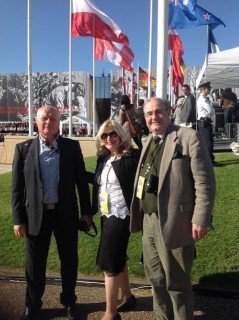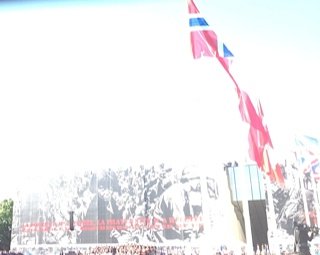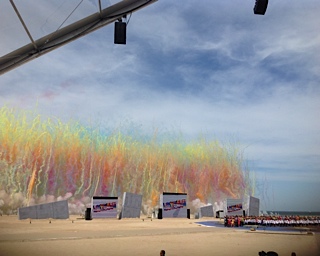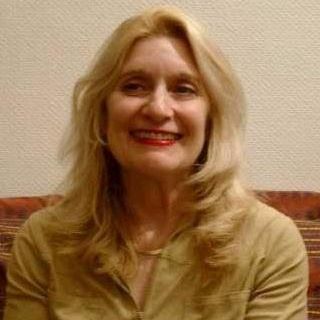D Day 2014
70th Anniversary of Liberation of France
by Jane Rosenstein

At 5:40 a.m. on June 6, 2014, I went with Gennadiy Sevastaynov and Michael Shrimpton of London, journalists from VT to the D Day Celebrations in Normandy, on a special train that left St. Lazare station. We were invited by the French Dept. of Foreign Affaires. After passing through security, we mounted the train. Shortly thereafter we were served a continental breakfast including crossants, rolls, jelly, coffee and tea.
We met other journalists who were looking forward to attending the ceremonies. About 100 French veterans and 800 foreign veterans were planning to attend the International Ceremony in Ouisterham, half of the veterans from Great Britain and one quarter from U.S.A.
The logo created for the event is in the form of both the dove of peace and the letter “V” for Victory. The “Land of Freedom” logo was designed to give a common identity to the events of the 70th Anniversary of the D-Day Landings and the Battle of Normandy, as well as the partners associated with this anniversary.
 Upon arrival in Caen, we were driven in a chartered bus to attend the French National Ceremony at 9 a.m. in front of the Memorial de Caen, where President Hollande paid tribute to the victims of the Battle of Normandy and honored the living civilians and veterans. A band played music, and then school children gave narratives in the first person of children and adolescents who witnessed the horrors of the battles. It was touching. The only problem was that there was no simultaneous interpretation for people who didn’t understand French. Fortunately, being a professional French/English intepreter, I could understand their speeches. President Hollande gave a speech in memory of the victims, both civil and military and greeted some of the veterans. We watched this on a closed-circuit T.V. screen.
Upon arrival in Caen, we were driven in a chartered bus to attend the French National Ceremony at 9 a.m. in front of the Memorial de Caen, where President Hollande paid tribute to the victims of the Battle of Normandy and honored the living civilians and veterans. A band played music, and then school children gave narratives in the first person of children and adolescents who witnessed the horrors of the battles. It was touching. The only problem was that there was no simultaneous interpretation for people who didn’t understand French. Fortunately, being a professional French/English intepreter, I could understand their speeches. President Hollande gave a speech in memory of the victims, both civil and military and greeted some of the veterans. We watched this on a closed-circuit T.V. screen.

We were driven to the International Ceremony in Ouistreham. The hall reserved for the press was large and included a buffet table for lunch, including French specialities such as foie gras, ham, tripe and of course cheese from Normandy. There was also a selection of desserts including French macaroons. Beverages included cider, apple juice, Calvados, water, coffee and tea; The buffet was delicious and open until midnight!
The press could avail themselves of PCs free of charge. Simultaneous interpretation headphones for President Hollande’s speech were available to hear the speech in English, Spanish, German and other languages, but journalists had to return the headsets or their publications would be charged 350 Euros.
We ate lunch and then walked to the bleachers reserved for journalists. The camermen were in a section in front of us, and one asked me if I could see the stage and he could not film for a TV station.
The site of the viewing facility is equal to an area of 15 soccer fields and included seating for 7,000 guests – 3,000 for veterans and those accompaning them and 1,000 journaists.
The ceremony began with a good muscial performance by a band with players from 9 countries; Belgium, Canada, Denmark, the Netherlands, Norway, Poland, UK, USA and France.
We watched intensely as the heads of state arrived. There were supposed to be 18 heads of state but then President Poroshenko from Ukraine was invited and attended. A special entrance for Queen Elizabeth II was made when the car she was riding approached the platform where Hollande was standing. The crowd applauded for her, and she shook hands with Hollande and then the World War II veterans.
President Hollande’s speech was touching as he descibed the horrors of war, honored the living veterans and paid homage to those deceased. He noted that “Resistance Fighters” and civilians through acts of courage and sacrifice made D-Day a victory for freedom.
President Hollande explained that World War 2 heros – the veterans had been 20 years old – some a little older, some a little younger, and had taken the responsibility to fight. He hoped that the Victory of the Allies would bring a world that is more peaceful and more fraternal. He said problems today of terrorism, misery and unemployment could lead to fighting. He said that this 70th anniversary celebration is significant because the World War II veterans are about 90 years old now and this will probably be the last decennial commemoration they can attend.
When I spoke to my friend Rob Robinson in Texas, he told me that his uncle Russel Robinson, now 90 years old, fought on Omaha Beach. He said that the French men and women in Normandy were very nice to him, but on arriving home in Mississippi, he faced racial discrimination against Blacks and had to sit in the back of buses and other discriminations.
The horrors of war – millions dead and graves with numbers containing unknown soldiers – are painful. Hollande not only gave a speech, but made us feel the pain of war.
He conveyed the idea that because of D-Day, the Normandy landings created a hope to rebuild Europe to be part of a better world, based on human rights, freedom and democracy.
President Hollande also recommended that the D-Day Landing Beaches be listed as a UNESCO World Heritage Site.
Imagine our surprise after President Hollande’s speech when we were surprised with fireworks. Afterwards, there was a 4-act scenography about the Second World War simultaneously with the projection on a closed-circuit TV about the horrors of war and rebuilding Europe. I found it very difficult and horrible to watch the Nazi brutalities, such as sending off children and adults to concentration camps and dumping corpses into communal graves! We saw Queen Elizabeth as a young woman visiting a factory.
The first scenography depicted the sufferings during World War II, occupation and collaboration. We see images of war fronts.
The longest day was the subject of the second scenography. High flames arise depicting war. Dancers dance symbolically and some fall down indicating death. A bag piper appears.

The third scenography is about the Long Way to Victory. It tells about the battles and bombings in Normandy. On the screen we see the atomic bomb and the discovery of concentration camps.
The fourth scenography is a choreography about hope from the founding of the UN and rebuilding of Europe. Veterans of different countries and Ouistreham children wearing the colors of the nations present appear.
The scenographies were very interesting and depicted events well.
The ceremonies of the 70th anniversary of the liberation of France gave the attendees an interesting experience from which they acquired a better understanding of the fighting on Normandy Beaches. They honored the memories of the civilians and veterans and gave us hope for peace and democracy that could unite all of us.


Jane Rosenstein is a U.S. citizen living in Paris, France. She is a professional translator/interpreter. She is the owner of The International Connection which does international marketing consultation including sales of wine, interpretation, and translation.
She enjoys the cultural life that living in Paris offers and has talents in organizing events. She speaks English, French, and Spanish. She has a B.S. degree in mathematics from the University of Pittsburgh and an M.B.A. degree from Georgia State University in Atlanta, GA.
ATTENTION READERS
We See The World From All Sides and Want YOU To Be Fully InformedIn fact, intentional disinformation is a disgraceful scourge in media today. So to assuage any possible errant incorrect information posted herein, we strongly encourage you to seek corroboration from other non-VT sources before forming an educated opinion.
About VT - Policies & Disclosures - Comment Policy



